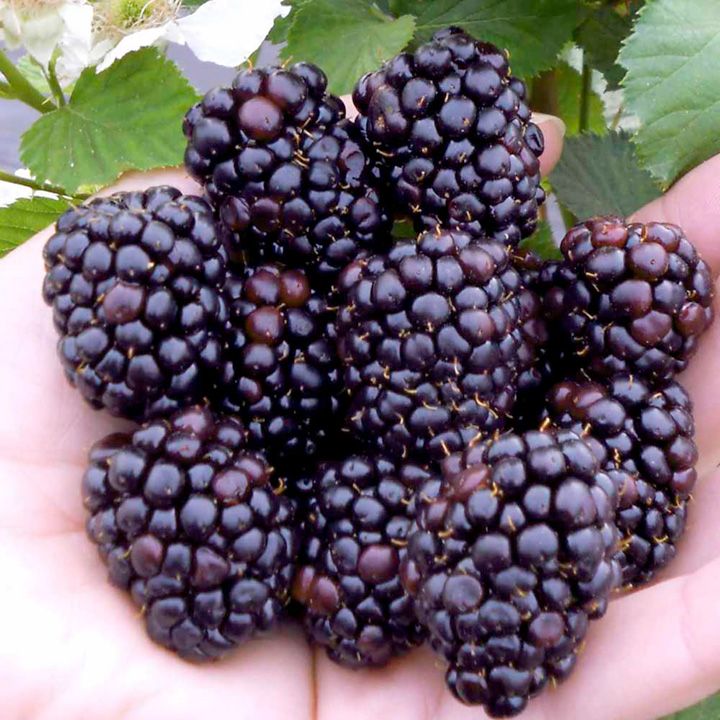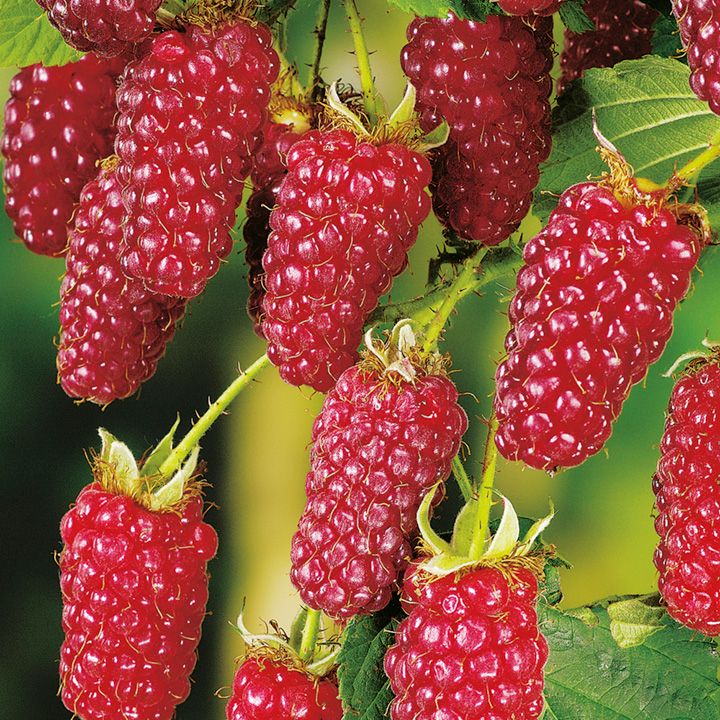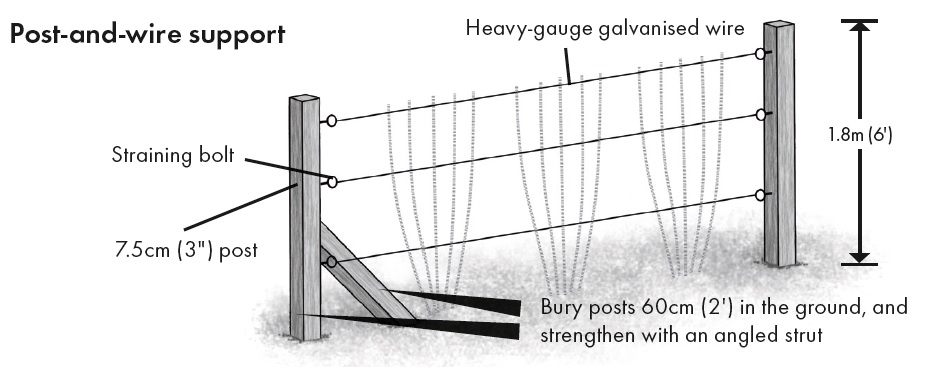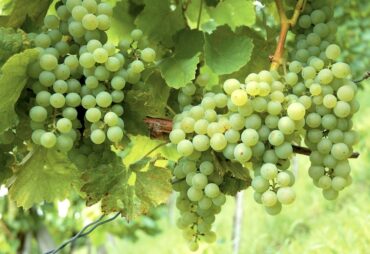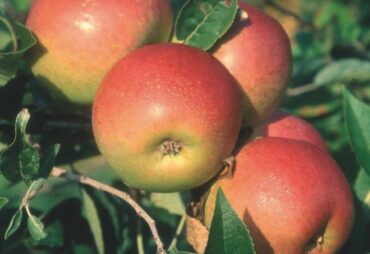Blackberries grow best in a well drained, fertile soil in a sunny or partially shaded position. They can even be planted against a north facing wall or fence but will fruit a little later in such a situation. The normal cropping period is early August to late September. If planting in the garden ideally the soil should be slightly acid with a pH of 6 to 6.5. This can easily be checked by using a soil test kit or a pH meter.
Some blackberry plants are well suited to growing in a large container – a small half barrel is ideal. Some support will be needed such as a wigwam of canes or a small trellis fan. The basic cultural method is similar although stopping of new growth in May will encourage lateral branches and give a bushier plant with an eventual concentration of fruit. If planting in a garden dig a planting hole large enough to accommodate the root system without squashing and set the plant so that, when replaced, the soil is at the same level as it was when grown in the nursery. Gradually fill the soil around the roots of the blackberry plant, shaking the plant lightly to settle the soil, and firm well, using the foot. Immediately after planting, prune the existing canes to a bud about 22cm (9”) from the ground.
Ensure that the plants do not become short of water, especially as establishment is taking place in the season after planting. When new shoots growing from the base are 5-8cm (2-3”) long, cut down the old canes to ground level. Should new shoots not appear in the first season, retain the old ones but remove any flower buds. Support with cane or trellis if not planted against a wall.
Loganberries, Tayberries and Tummelberries need a well-drained, fertile soil of good depth and, though they can be planted in partial shade, they are better when grown in full sun: avoid cold, exposed positions.
Loganberry cropping is from mid-July to mid-August. Pick when the fruits are a burgundy red colour. Tayberry fruits start to ripen in early/mid-July and fruiting continues well into August. The berries are a dark, purplish red in colour when ripe.
Tummelberries start to ripen in mid-July about a week later than Tayberries. The fruits are redder and less purple than Tayberries. Ideally, the soil should be slightly acid with a pH of 6 to 6.5. This can easily be checked by using a soil test kit or a pH meter. Deep soil cultivation is recommended, preferably digging to the depth of a spade, plus forking of the soil layer below. Be sure to remove all traces of perennial weeds. For each plant, incorporate a 5-8cm (2-3″) layer of well-rotted manure, or garden compost into the top 25cm (10″) of soil, over an area of 75cm (2½’) square. Fork in 70g (2oz) of Growmore or a similar general fertiliser, over the same area.
Loganberries, Tayberries and Tummelberries have a spreading habit of growth – when trained, up to 3 metres (10′) or so for Loganberries: 2.4 metres (8′) for Tayberries and Tummelberries.
Blackberry Loch Ness has an upright growth habit which is ideal for growing on wires and the plant ‘spread’ is similar to Tayberries. Plants develop to a height of 1.8 – 2.4 metres (6-8′) and they require some form of support.
Train the plants on wires (10-12 gauge) against a wall, fence, or garden shed. Alternatively, wires can be strained on stout posts – 2.4 metres (8′) long with about 60cm (2′) buried below soil level. Either way, set the wires at 30cm (1′) apart with the bottom strand 90cm (3′) above ground level. Planting and Initial Treatment Bear in mind that birds can be attracted to the developing fruits and protection may be advisable. If a fruit cage is available, the plants can be grown in this or, alternatively, netting of the plants can be undertaken at fruiting time.
Remove the polythene and protective material from around the roots. Soak them in tepid water for a few hours if they are at all dry. Dig a planting hole large enough to accommodate the root system without squashing and set the plant so that, when replaced, the soil is at the same level as it was when grown in the nursery. Gradually fill the soil around the roots, shaking the plant lightly to settle the soil, and firm well, using the foot. If more than one Loganberry is being planted, set them 3 metres (10′) apart.
Allow 2.4 metres (8′) between Blackberry, Tayberry or Tummelberry plants. Should planting not be possible for some time, heel in plants temporarily. To do this, dig a shallow v-shaped trench to accommodate the roots, set the plants close together along one side of this trench, replace the soil and firm it around the roots. Immediately after planting, prune the existing canes to a bud about 22cm (9″) from the ground. Ensure that the plants do not become short of water, especially as establishment is taking place in the season after planting. When new shoots growing from the base are 5-8cm (2-3″) long, cut down the old canes to ground level. Should new shoots not appear in the first season, retain the old ones but remove any flower buds.
Training and Pruning
Fruit will not be produced in the first season but the new canes that develop should be tied to the wires. These canes will carry the crop in the following year. Training can be carried out in several ways. Probably the easiest method is to arrange the canes so that they fan out on both sides of the plant. Do not tie in any canes in the centre immediately above the plant itself.
The following year this space can be utilised for temporarily tying in the new canes in a more or less upright position. They can be loosely bunched together in ‘sheaves’ so that they take up less space and do not become tangled with the older fruiting canes. Once harvesting is completed, cut out all the old fruiting canes down to soil level. Then, tie in the young canes, spacing them fanwise.
Container Planting
The more compact varieties of blackberry are well suited to growing in a large container – a small half barrel is ideal. Some support will be needed such as a wigwam of canes or a small trellis fan. The basic cultural method is similar although stopping of new growth in May will encourage lateral branches and give a bushier plant with an eventual concentration of fruit.
Feeding
When berry and blackberry growing, during the late winter apply Sulphate of Potash at 35g per sq. metre (1oz per sq. yard) and then in March, Sulphate of Ammonia at 15g per sq. metre (½oz per sq. yard). Instead of separate dressings, Growmore, or a similar general fertiliser can be used in late February at 70g per sq. metre (2oz. per sq. yard). In either case, in late March, apply a 5cm (2″) surface layer (mulch) of well rotted manure or garden compost.
Fruit Freezing
The fruits of these plants freeze well. Rinse the fruits quickly in cold water and drain. Then turn the fruits gently in dry sugar until they are evenly coated. For Blackberries, use about 100g of caster sugar per 500g of fruit (4oz. sugar to 1lb fruit). Use 60g caster sugar per 500g of fruit (2oz. sugar to 1lb. fruit) in the case of Loganberries, Tayberries and Tummelberries. Leave in a covered bowl for about 2 hours to allow the sugar to draw sufficient moisture from the fruit to produce a coating of syrup. Pack the coated fruits in containers and place in the freezer.
Last Updated on March 10, 2023 by Suttons Horticultural Team

